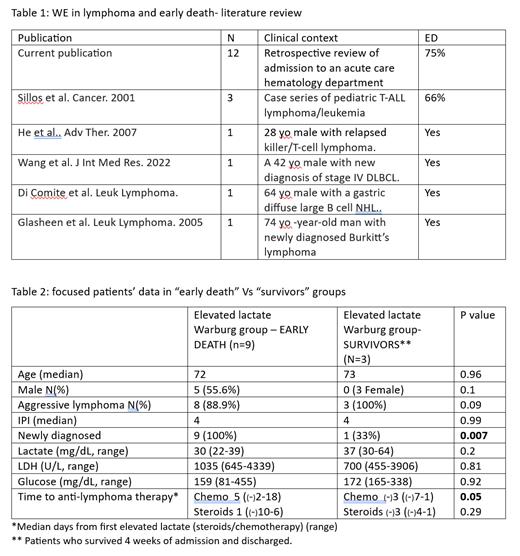Introduction: Lactic acidosis is a medical emergency and in most cases results from an imbalance between tissue oxygenation and oxygen demand (Type A). However, Type B lactic acidosis occurs in the absence of a recognizable impairment in systemic oxygen delivery, and is most commonly associated with drug or toxin ingestion, sepsis, severe nutritional deficits such as thiamine, and less commonly, malignancy.
The capacity of shifting glucose metabolism to anaerobic pathway despite the presence of adequate oxygen, enhancing the rate of glucose uptake, accelerated glycolysis and hence producing more lactate, is a well-defined phenomenon in malignant cell metabolism, and is called the Warburg Effect (WE) or aerobic glycolysis.
A systemic rise in lactate and lactic acidosis has been reported in hematologic malignancies and less commonly in solid tumors, and is thought to occur as a consequence of both increased production of lactate- reflecting high malignancy burden, and impaired lactate turnover or elimination by liver or kidney.
Few case reports or series have demonstrated a possible correlation between early death and elevated lactate in patients with hematologic malignancy (Table 1).
We aimed to characterize the incidence and clinical impact of Warburg-driven lactic acidosis on outcome including early death.
Methods:
A retrospective study of patients admitted to the haemato-oncology department in a large tertiary medical center between the years 2013- 2022, that presented with elevated lactate levels during the first week of admission. Patients with hematologic diseases other than lymphoma were excluded. Of 40 patients reviewed, 21 patients were excluded because of underlying hematological malignancy other than lymphoma. Medical records were retrieved and reviewed for a recognizable cause for elevated lactate, or non (assigned as the WE group). Early-death was defined as death of any cause within 4 weeks of admission.
Results:
Nineteen patients had lymphoma and elevated lactate levels within the first week of admission. Of these, 12 patients fulfilled the criteria for WE and 7 patients had their high lactate attributed to other causes such as hemorrhagic shock (n=1), sepsis (n=5) and concomitant metformin use (n=1).
Median age among patients with WE was 72.5 years (range 66-86) with 41.6% (n=5) males. All but one had aggressive lymphoma. Diffuse Large B cell Lymphoma was the most frequent type (n=9) followed by T cell Lymphoma (n=2) and follicular lymphoma (n=1). Most patients had advanced disease (Stage III-IV in 75%) and the median International Prognostic Index (IPI) of the patients was 4 (range 3-5). The median lactate level was 31.5 mg/dL (range 25-64; with upper limit of normal value-20 mg/dL). Two patients received thiamin therapy once WE was recognized.
Early-death rate was 75% (9 patients) among patients with WE. The established cause of death in this population was: sepsis (n=3), DIC (n=1), uremia and multi organ failure (n=2) and respiratory failure due to lung infiltration by lymphoma (n=3).
Both steroid and chemotherapy were initiated earlier in surviving patients as compared to those who died early (within 4 weeks of admission); in surviving patients, chemotherapy was initiated at a median of 3 days before first elevated lactate was detected (range (-)7-1), and steroids at median of 3 days before first elevated lactate was detected, while in those who died early, chemotherapy was initiated at median of 5 days after first elevated lactate was detected (range (-)2-18) and steroids at median 1 day after first elevated lactate (p=0.29 and 0.05 for steroids and chemo, respectively). (Table 2).
Conclusion: Warburg driven lactic acidosis is a marker of ‘acute cancer’ in lymphoma patients and is associated with a very high mortality rate. Early recognition of this very high-risk clinical scenario is of utmost importance and should prompt immediate anti-lymphoma therapy that may improve outcome.
Disclosures
Raanani:Janssen: Consultancy, Research Funding; BMS: Consultancy, Research Funding; Pfizer: Consultancy, Research Funding; Novartis: Consultancy, Research Funding. Gurion:Medison: Honoraria; Takeda: Honoraria; Gilhead: Honoraria; Novartis: Honoraria; Roche: Honoraria; Abbvie: Honoraria. Wolach:Abbvie: Consultancy, Honoraria, Research Funding; Astellas: Consultancy, Honoraria; Medison: Honoraria.


This feature is available to Subscribers Only
Sign In or Create an Account Close Modal